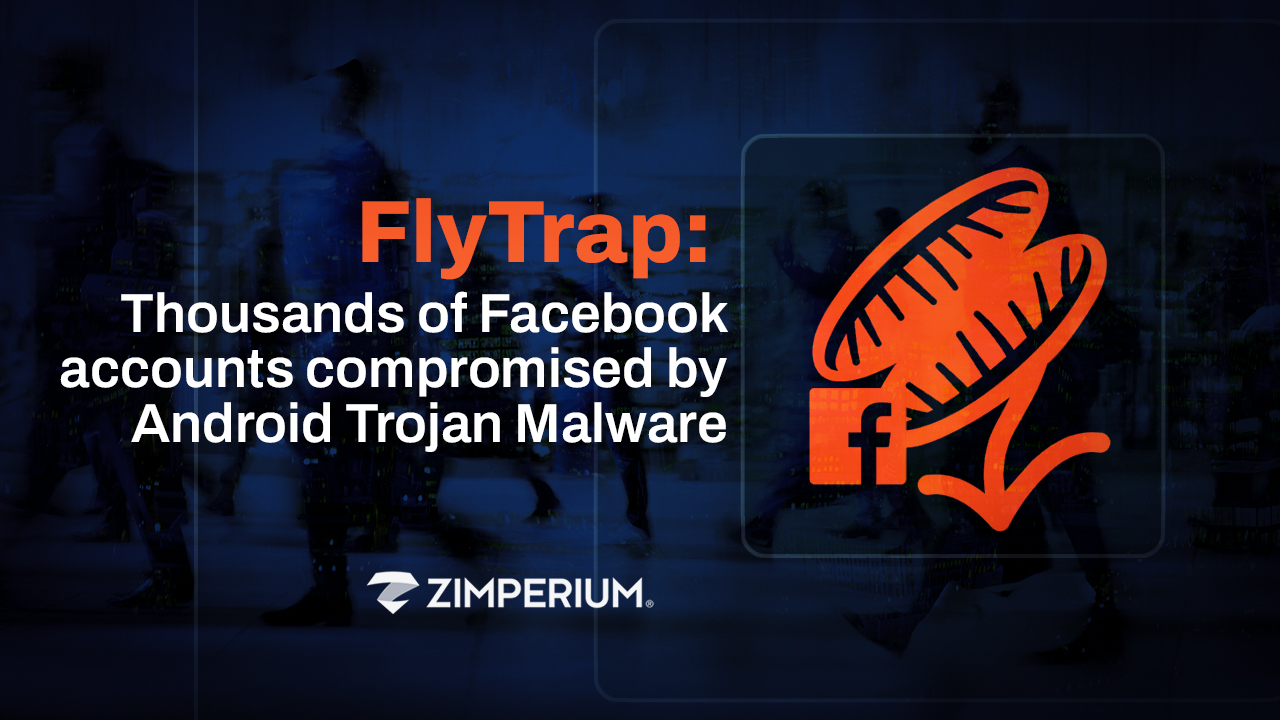FlyTrap Android Malware Compromises Thousands of Facebook Accounts
A new Android Trojan codenamed FlyTrap has hit at least 140 countries since March 2021 and has spread to over 10,000 victims through social media hijacking, third-party app stores, and sideloaded applications.
Zimperium’s zLabs mobile threat research teams recently found several previously undetected applications using Zimperium’s z9 malware engine and on-device detection. Following their forensic investigation, the zLabs team determined this previously undetected malware is part of a family of Trojans that employ social engineering tricks to compromise Facebook accounts.
Forensic evidence of this active Android Trojan attack, which we have named FlyTrap, points to malicious parties out of Vietnam running this session hijacking campaign since March 2021. These malicious applications were initially distributed through both Google Play and third-party application stores. Zimperium zLabs reported the findings to Google, who verified the provided research and removed the malicious applications from the Google Play store. However, the malicious applications are still available on third-party, unsecured app repositories, highlighting the risk of sideloaded applications to mobile endpoints and user data.
Disclosure: As a key member of the Google App Defense Alliance, Zimperium scans applications prior to publishing, as well as providing ongoing analysis of Android apps in the Google Play Store.
In this threat blog, we will:
- Cover the capabilities of the FlyTrap Trojan;
- Discuss the techniques used to collect and store data;
- Demonstrate the communication with the C&C server to exfiltrate stolen data; and
- Explore the victimology and impact.
What Can FlyTrap Trojan Do?
The mobile application poses a threat to the victim’s social identity by hijacking their Facebook accounts via a Trojan infecting their Android device. The information collected from the victim’s Android device includes:
- Facebook ID
- Location
- Email address
- IP address
- Cookie and Tokens associated with the Facebook account
These hijacked Facebook sessions can be used to spread the malware by abusing the victim’s social credibility through personal messaging with links to the Trojan, as well as propagating propaganda or disinformation campaigns using the victim’s geolocation details. These social engineering techniques are highly effective in the digitally connected world and are used often by cybercriminals to spread malware from one victim to another.
How Does FlyTrap Trojan Work?
The threat actors made use of several themes that users would find appealing such as free Netflix coupon codes, Google AdWords coupon codes, and voting for the best football (soccer) team or player. Initially available in Google Play and third-party stores, the application tricked users into downloading and trusting the application with high-quality designs and social engineering. After installation, the malicious application displays pages that engage the user and asks for a response from them, such as the ones shown below.
Figures 1-6: The screens displayed upon installation and launch of the FlyTrap Trojans.
The engagement continues until the user is shown the Facebook login page and asks to log in to their account to cast their vote or collect the coupon code or credits. All this is just another trick to mislead the user since no actual voting or coupon code gets generated. Instead, the final screen tries to justify the fake coupon code by displaying a message stating that “Coupon expired after redemption and before spending.” The following images show one of the applications’ UI navigation.
Figure 7-12: The graphical flow of the FlyTrap Trojans finally leading to the login page
Contrary to popular belief that a phishing page is always at the forefront for compromising or hijacking an account, there are ways to hijack sessions even by logging into the original and legit domain. This Trojan exploits one such technique known as JavaScript injection.
Using this technique, the application opens the legit URL inside a WebView configured with the ability to inject JavaScript code and extracts all the necessary information such as cookies, user account details, location, and IP address by injecting malicious JS code.
Figure 13: A code snippet containing the type of data to be exfiltrated to the C&C server
The manipulation of web resources is addressed as cross-principal manipulation (XPM) in the research “An Empirical Study Of Web Resource Manipulation In Real-world Mobile Applications.” Successful login into Facebook by the victim initiates the data exfiltration process and can be seen in the below screenshots of the communication with the C&C server.
Figure 14,15: The exfiltrated cookie information matches the legitimate cookie
Several of the Trojans have the same malicious script and therefore identifies the source of data by the parameter “from_app” as seen in the screenshots below.
Figure 16-18: The exfiltrated cookie information matches the legitimate cookie
The Command & Control server makes use of login credentials for authorizing access to the harvested data. Security vulnerabilities in the C&C server expose the entire database of stolen session cookies to anyone on the internet, further increasing the threat to the victim’s social credibility.
Figure 19: One of the Command & Control servers that stores hijacked sessions
The Victims of FlyTrap Trojan
The exposed database contains the geolocation information of several thousands of victims based on which, the victimology map shown below was generated. The Zimperium zLabs mobile threat research team found over 10,000 victims across 144 countries to date, which illustrates the impact of the social engineering campaign.
Figure 20: Thousands of the victims are spread across 144 countries
Zimperium vs. FlyTrap Trojan
Zimperium zIPS customers are protected against FlyTrap Trojan with our on-device z9 Mobile Threat Defense machine learning engine.
To ensure your Android users are protected from FlyTrap Trojan malware, we recommend a quick risk assessment. Any application with FlyTrap will be flagged as a Suspicious App Threat inside zConsole. Admins can also review which apps are sideloaded onto the device that could be increasing the attack surface and leaving data and users at risk.
Summary of FlyTrap
Malicious threat actors are leveraging common user misconceptions that logging into the right domain is always secure irrespective of the application used to log in. The targeted domains are popular social media platforms and this campaign has been exceptionally effective in harvesting social media session data of users from 144 countries. These accounts can be used as a botnet for different purposes: from boosting the popularity of pages/sites/products to spreading misinformation or political propaganda.
Just like any user manipulation, the high-quality graphics and official-looking login screens are common tactics to have users take action that could reveal sensitive information. In this case, while the user is logging into their official account, the FlyTrap Trojan is hijacking the session information for malicious intent.
FlyTrap is just one example of the ongoing, active threats against mobile devices aimed at stealing credentials. Mobile endpoints are often treasure troves of unprotected login information to social media accounts, banking applications, enterprise tools, and more. The tools and techniques used by FlyTrap are not novel but are effective due to the lack of advanced mobile endpoint security on these devices. It would not take much for a malicious party to take FlyTrap or any other Trojan and modify it to target even more critical information.
Indicators of Compromise
FlyTrap Trojan Android applications:
- com.luxcarad.cardid : GG Voucher
- com.gardenguides.plantingfree : Vote European Football
- com.free_coupon.gg_free_coupon : GG Coupon Ads
- com.m_application.app_moi_6 : GG Voucher Ads
- com.free.voucher : GG Voucher
- com.ynsuper.chatfuel : Chatfuel
- Com.free_coupon.net_coupo n : Net Coupon
- com.movie.net_coupon : Net Coupon
- com.euro2021 : EURO 2021 Official
- 00833ff71a1709e60cb04acbcc7ceecd56323e693de3c424fb37205204d43105
- fa08c2ca7d8614be2b0b58095d0f3115464e9139bf5051c4f3da15963bb31062
- 30a3ad09199660baca6410a4ada290887390d9453d95eb1e84bdd984c89ecc3a
- 8e6c98b247a2bb34d5004c3f14d2cbf2a22c987f960e86c760d44766f9361c59
- 21b85beb9992fccb268fcef2904c5e6591a3c80b7fa8dd201e28782887fea2cb
- d1cf14ccbc8f718111e59f9173475b2882dc6d1ca381ff3b726f2b471711aa7e
- c4eed338a3449c57eb919eac9a41b5b5ca4d0223fda341005e68f5b673d745ad
- 3b0137302a6b93cc4dd4d0a58749fc959f8d9ad26d022d6b10dc3d7608af3279
- 3cd5cee4326d48c0b1f0c40d3b8f3e0d7ef7ef2b782afbe95e07a3d519ba5aee
- 1a3b448853479bf6b23d283bd44b0458132c3cda1648eac631dfdc178aee5ac0
- 5d671f5ed5e5855dc5727412b2a9293f42b7b5f31c3b924a30beacd8304863b6
- 64f4f085050294d064860d0c9e323bbf21cb4f66773944646a9eaf4eab49e115
- 8e2aa1a1a144f84511aafd76c83a23e33c3c107c914bb67761df32f6b68b6cf5
- 96b235bc715d6089a163ca212d1e752c26918b3d3b1acec5bdebbdd1b40c4b85
- f8845f98ca1233b6db2ef44913a115f3093308846ba805aaaf21753d97e4219c
Command and Control Servers:
- hxxp://47.57.237.26
- hxxp://165.232.173.244:3023
- hxxps://manage-ads.com
- hxxp://quanlysanpham.work
About Zimperium
Zimperium, the global leader in mobile security, offers the only real-time, on-device, machine learning-based protection against Android, iOS, and Chromebook threats. Powered by z9, Zimperium provides protection against the device, network, phishing, and malicious app attacks. For more information or to schedule a demo, contact us today.









